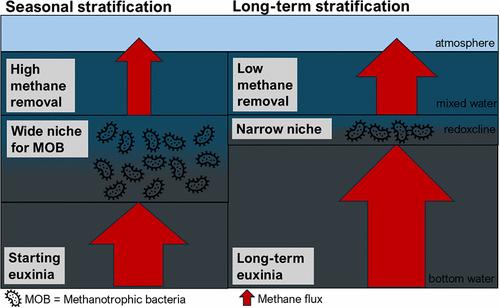富营养化沿海盆地长期缺氧对微生物甲烷去除的限制
IF 11.3
1区 环境科学与生态学
Q1 ENGINEERING, ENVIRONMENTAL
引用次数: 0
摘要
在富营养化沿海水域,好氧甲烷氧化细菌(MOB)通过氧化底栖甲烷来减少甲烷排放,即使在分层的缺氧水柱中也是如此。然而,持续的变暖和富营养化导致分层期延长,加强了缺氧和硫化物条件(缺氧),潜在地影响了甲烷的去除能力。在这里,我们比较了2022年夏季斯德哥尔摩群岛不规则、季节性和长期缺氧地点之间的总体水柱甲烷去除量。长期缺氧底水条件下,水体-空气甲烷排放量、底水-甲烷和硫化物积累量最高,甲烷氧化电位最低。虽然MOB的相对丰度和潜在活性表明甲烷生物过滤器在季节性缺氧底水层具有较高的功能,但在长期缺氧底水层中甲烷过滤潜力要低得多。在持续的缺氧条件下,总体细菌多样性和微生物网络连通性较低,可能是由于氧化还原条件的同时转变和厌氧硫循环的转变。这种转变可能会迫使MOB从缺氧的底部水退回到狭窄的氧层中,从而降低甲烷生物过滤器的容量,导致甲烷排放量增加。这些发现强调了正反馈循环可以进一步扩大海洋甲烷排放,特别是在全球变暖的情况下,富营养化和浅海沿岸水域容易延长分层。本文章由计算机程序翻译,如有差异,请以英文原文为准。

Long-Term Euxinia Restricts Microbial Methane Removal in Eutrophic Coastal Basins
In eutrophic coastal waters, aerobic methane-oxidizing bacteria (MOB) mitigate methane emissions by oxidizing benthic methane even in the stratified, anoxic water column. However, ongoing warming and eutrophication lead to extended stratification periods, enhancing anoxic and sulfidic conditions (euxinia), potentially affecting methane removal capacity. Here we compared overall water column methane removal between sites with irregular, seasonal and longer-term euxinia in the Stockholm Archipelago during summer 2022. The highest water–air methane emissions, bottom water–methane and sulfide accumulation, and the lowest methane oxidation potential were observed under longer-term euxinic bottom water conditions. While MOB relative abundance and potential activity indicated high functioning of the methane biofilter in the seasonally euxinic bottom water layer, the methane-filtering potential was much lower in the longer-term euxinic bottom water. Under persistent euxinic conditions, overall bacterial diversity and microbial network connectivity were lower, likely following a simultaneous shift in redox conditions and a shift toward anaerobic sulfur-cycling. This shift may force MOB to retreat from the euxinic bottom water into the narrow oxycline, reducing the capacity of the methane biofilter and resulting in higher methane emissions. These findings highlight the positive feedback loop that can further amplify oceanic methane emissions, particularly from eutrophic and shallow coastal waters prone to prolonged stratification under global warming.
求助全文
通过发布文献求助,成功后即可免费获取论文全文。
去求助
来源期刊

环境科学与技术
环境科学-工程:环境
CiteScore
17.50
自引率
9.60%
发文量
12359
审稿时长
2.8 months
期刊介绍:
Environmental Science & Technology (ES&T) is a co-sponsored academic and technical magazine by the Hubei Provincial Environmental Protection Bureau and the Hubei Provincial Academy of Environmental Sciences.
Environmental Science & Technology (ES&T) holds the status of Chinese core journals, scientific papers source journals of China, Chinese Science Citation Database source journals, and Chinese Academic Journal Comprehensive Evaluation Database source journals. This publication focuses on the academic field of environmental protection, featuring articles related to environmental protection and technical advancements.
 求助内容:
求助内容: 应助结果提醒方式:
应助结果提醒方式:


